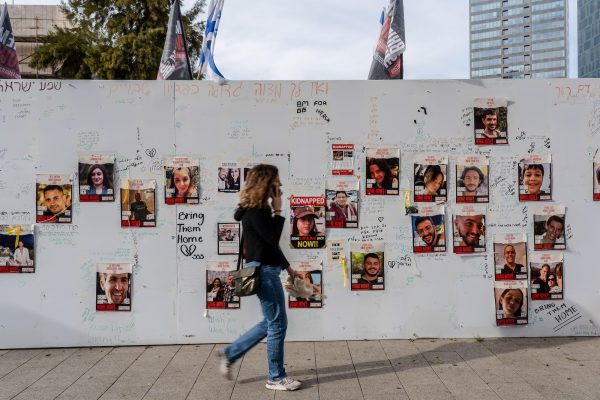On May 28, in his commencement address at West Point, President Barack Obama announced a $5 billion Counterterrorism Partnerships Fund, which “will allow us to train, build capacity, and facilitate partner countries on the front lines.” This plan indicates a change in tactics rather than a change in strategy. It unfolds what will likely be known as the “Obama Doctrine”: disengaging U.S. troops from foreign entanglements, and filling the gap by supporting the efforts of America’s local allies to fight terrorist groups. In reality, this approach makes the world a more dangerous place.
The money is destined for the Middle East and North Africa. However, such a fund will only amplify the United States’s misguided proclivity to seek military solutions to political problems. From West Africa to Central Asia, American money has been poured into funding, training and equipping counter-terrorist special forces. This in turn has contributed to corruption, conflict, the growth of police states—and a more complicated and deeply-entrenched terrorist threat. Analysts at the Combating Terrorism Center at West Point note that, in aid-recipient states where terrorism is present but the threat is low, “providing economic and security assistance to combat terrorism based on the presence of terrorists, or the severity of its threat, actually risks increasing the expected future level of terror in that target state.
There are four variants to the threat that arises when the U.S. supports local military establishments. First, the government receiving the funds may manipulate counter-terror operations for its own political purposes. Take Ethiopia, for instance. Close observers of militant Islamism in the Horn of Africa say that al-Qaeda affiliates were largely defeated before September 11—their cells broken, their sponsors intimidated. Small numbers of Islamist extremists were hiding out in Somalia—but unlike Afghanistan, Somalia is a commercially open society where anonymity is impossible. But Ethiopia was also fighting a proxy war with Eritrea, with Somalia as the battleground, and was deeply fearful of Eritrea’s capacity to destabilize the region. In December 2006, espying Eritrean advisers in Mogadishu, Ethiopia sent its troops into Somalia. To garner U.S. support, it announced that it was targeting al-Shabaab. The United States bought the ruse and ended up as partner and sponsor in a military mission. Seven and a half years later, there is no end in sight.
Al-Shabaab grew in strength only after the Ethiopian invasion; it did not become affiliated with al-Qaeda until 2012. According to Somalia expert Markus Hoehne, “Somalia since 2006 is possibly the clearest example of the failure of U.S. (and Ethiopian) counter-terrorism policy, which actually has produced what it was supposed to counter.” This exemplifies the second problem with militarized counter-terrorism: violence antagonizes the local people, and local young men flock to extremists from desperation or revenge.
Kenya’s response has been, if anything, worse. Following al-Shabaab’s kidnapping of Spanish aid workers in Kenya, and other terrorist acts, the Kenyan army invaded Somalia. The brutality of Kenyan troops, coupled with the Somali outrage at the occupation of their lands by foreigners, sparked an escalation of terrorist attacks inside Kenya. The assault on the Westgate Mall in Nairobi in September 2013, which left 67 people dead, was the worst of a dozen recent attacks. But the Kenyan response only aggravated tensions. The siege at the Mall was over within a day, with the terrorists dead and the security services and army in control of the shopping center—which they proceeded to loot over the next few days, while sealing off the site on the pretext that al-Shabaab fighters were still inside. Photographs from the immediate aftermath show ransacked shops and empty beer bottles strewn across the floor. Whatever the crimes of al-Shabaab, drunkenness is not among them. Furthermore, indiscriminate crackdowns on the 150,000 Somali refugees in Kenya, including many Kenyan citizens of Somali origin, have only antagonized and alienated Somalis. Thousands have been locked up, and the neighborhood of Eastleigh, where many Somalis live, has become the locus of a fierce security crackdown. In one infamous case, police took a mother away from her six-month old baby, who starved to death while she was held in police cells.
Third, security cooperation usually generates black budgets within recipient governments. Generals, security chiefs, and their political masters become addicted to these funds, which foster a “deep state” that is beyond the reach of public scrutiny and democratic accountability. The money itself—further augmented by the kick-backs that accompany weapons procurements and contracts with private security companies—reinforces the system and discourages democratization. The forces funded, trained, and equipped for a counter-terrorist mission end up pursuing other corrupt or anti-democratic ends. In Mali, for instance, troops that had received U.S. training ended up corrupt and ineffective in the face of a rebel attack—and one of them mounted a coup.
For cash-strapped rulers, there are obvious advantages to putting your soldiers on a foreign payroll, in a situation in which you control the information about the threat and the response. President Yoweri Museveni of Uganda has benefited from international security assistance to fight the Lord’s Resistance Army (LRA)—put on the U.S. Terrorist Exclusion List in 2001—and, more importantly for him, has been able to maintain a high defense budget which is outside domestic or international scrutiny. The Ugandan journalist Andrew Mwenda documented how the chance to pursue the LRA enabled an eight-fold increase in defense spending between 1992 and 2010. Defense procurement scandals and an inflated army payroll with thousands of “ghost soldiers” pointed to endemic corruption—and also to an off-budget political fund that Museveni uses to bribe politicians and stay in power. Uganda also contributes troops to the African Union Mission in Somalia—an exercise advertised as both counter-terrorism and peacekeeping. Uganda’s military budget benefits from the international community not only covers the salary and deployment costs for each soldier, but also earns a handsome subsidy paid direct to the ministry of defense’s coffers.
In the final variant of unintended outcomes, the national ruler who is receiving the funds finds them so useful that he cannot afford to defeat terrorist groups, because that would deprive him of national budget. In Yemen, according to Sarah Phillips, “crisis has kept the system running, and has been, to a significant degree, a deliberate choice of Yemen’s power elite.” President Ali Abdullah Saleh used the threat of al-Qaeda linked insurgents to maintain generous security assistance and cooperation from the United States, an income stream that was not subject to any of the stringent governance and accountability preconditions that are attached to official development aid. Aid was cut and the United States insisted on credible political reform. As Phillips says:
The message that was, certainly unintentionally, conveyed to President Saleh during his trip to the United States was that without the threat of al-Qaeda, Yemen would be subject to much more stringent conditions on its domestic politics. Just months after this, in February 2006, 23 al-Qaeda suspects broke out from a maximum-security prison in such an audacious escape that it is widely understood to have been impossible without inside assistance. . . . Some of those 23 men went on to establish al-Qaeda in the Arabian Peninsular (AQAP), putting Yemen’s problem with militant jihadis back on the international agenda.
This is but one episode in a story of Saleh “dancing on the heads of snakes”— his own description of governing Yemen. He was more threatened by the prospect of a reduced security and political budget than by Islamist militants, and acted accordingly.
The U.S. officers who are involved in training and supplying foreign fighters are well aware of how their activities can misfire. Local forces can seize U.S. resources, as in an attack by Libyan militia on a U.S. training base in which they stole large quantities of specialized equipment and vehicles, and U.S.-trained special forces may defect to the other side.
But greater safeguards on operations and better oversight of the funds cannot fix the central problem, and nor can the Harmony Project’s proposal to link counter-terrorist aid to recipient government performance (rather than level of threat). Almost without exception, rulers in countries affected by Islamist insurgency tend to run their governments as secretive, militarized kleptocracies. (Or, as Sarah Chayes argues, “Every country that harbors an extremist insurgency today suffers from kleptocratic governance, including long-established U.S. allies.”) If the United States provides black-budget money, and trains and equips special forces, it supports the government in power—its bribery and coercion. During the Cold War, the United States and U.S.S.R. each supported client states in Africa and the Middle East, in a zero-sum geo-strategic game that denied citizens’ the right to change their own governments. This is still how a security cooperation relationship works, and we should have no illusions. And in turn, that kind of government generates popular resistance, including extremism.
The central lessons are well worn but nonetheless worth re-stating. First, the main effort in counter-terrorism should be social and political reform in affected countries, and second—for the United States—a national security strategy cannot substitute for a foreign policy that is aimed at finding political solutions to political problems.







